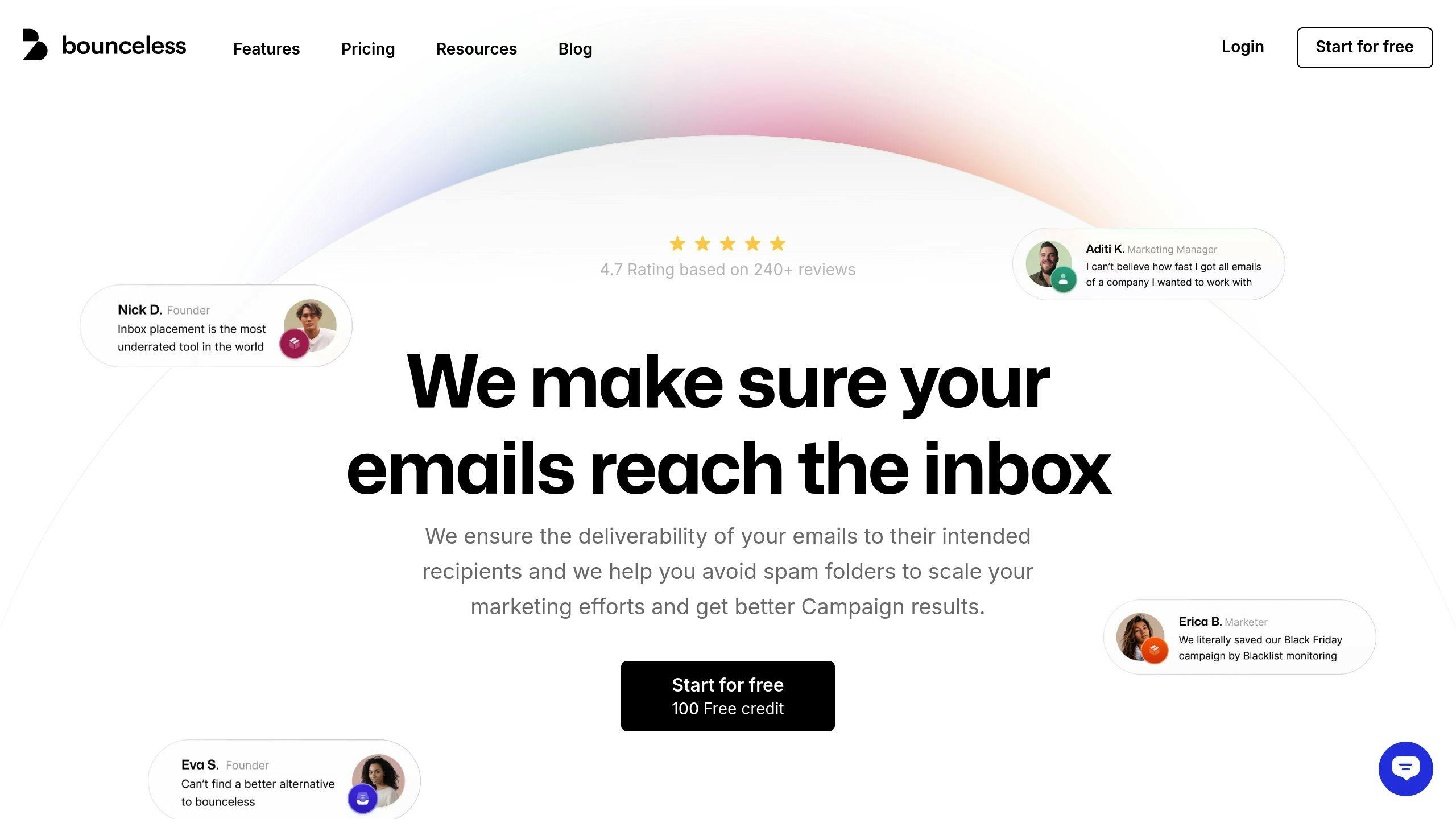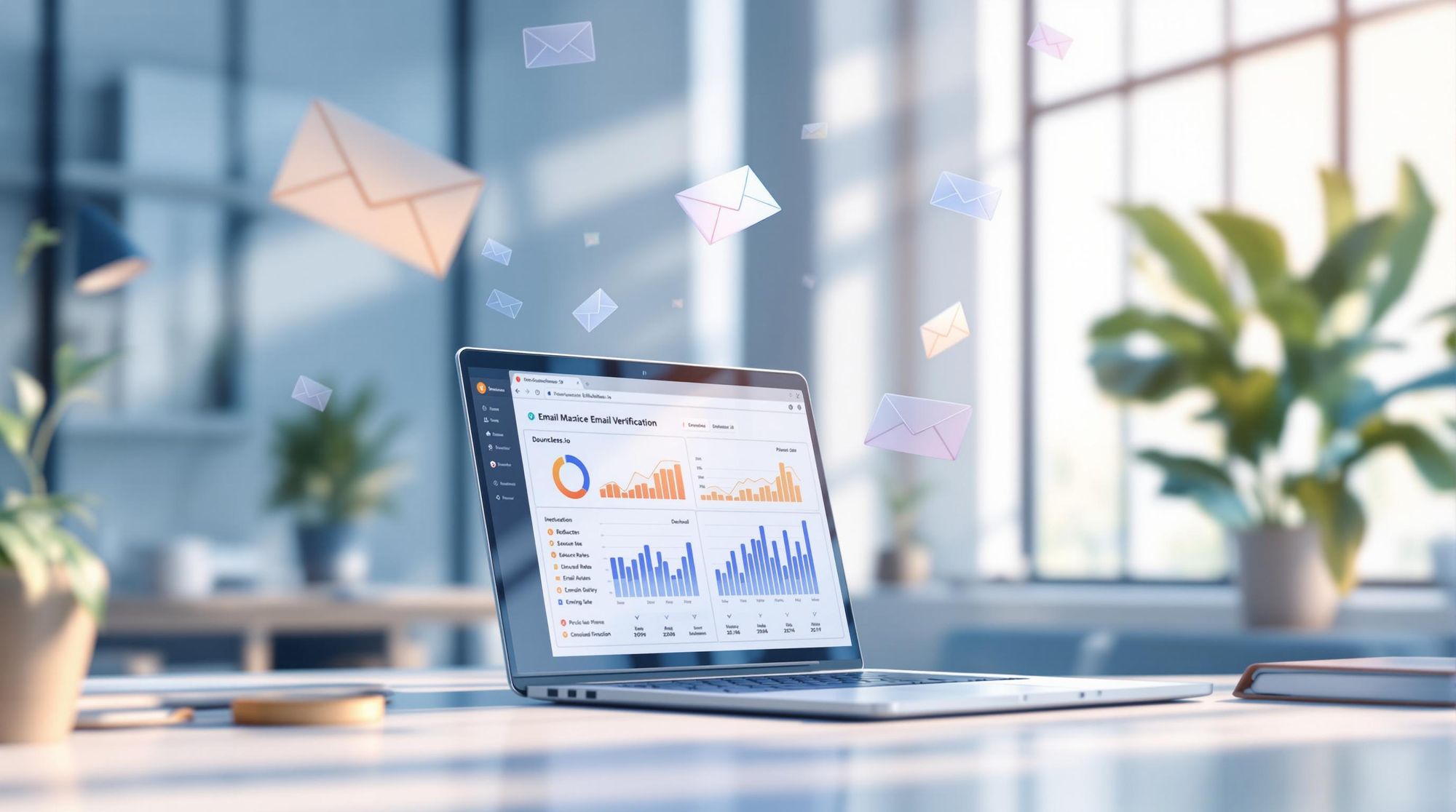High email bounce rates hurt your sender reputation, lower deliverability, and can even lead to blacklisting. Email verification APIs are the fastest and most accurate way to clean your email list and reduce bounces. Here's what you need to know:
Key Takeaways:
- Bounce Types:
- Hard Bounces: Permanent issues like invalid emails or non-existent domains.
- Soft Bounces: Temporary problems like full inboxes or server issues.
- Healthy Bounce Rate: Below 2%. Anything above 5% signals a problem.
- Impact of High Bounce Rates: Damaged sender reputation, blacklisting, and poor campaign performance.
Why Email Verification APIs Work:
- Fast Processing: Verifies thousands of emails in minutes.
- Accurate Checks: Validates domains, detects spam traps, and flags invalid addresses.
- Scalable & Secure: Handles large lists while staying GDPR-compliant.
Manual Cleaning vs. APIs:
| Feature | Email Verification APIs | Manual Cleaning |
|---|---|---|
| Speed | Thousands of emails in minutes | Hours for a few hundred |
| Accuracy | Up to 99% | 60-70% (prone to errors) |
| Scalability | Handles millions | Unmanageable for large lists |
| Cost Efficiency | Predictable pricing | Hidden labor costs |
For small lists, manual cleaning might work. But for larger campaigns, automated tools like Bounceless API are faster, more accurate, and cost-effective. Keep your bounce rate under 2%, protect your sender reputation, and improve deliverability with automated email verification.
Why Do Emails Bounce? Reduce Email Bounce Rate in 4 Ways
1. How Bounceless Performs

Bounceless is a strong contender in the world of email verification APIs, delivering reliable results in reducing bounce rates across several critical areas.
Speed and Processing Power
This platform handles large email lists with ease, providing quick, real-time results - perfect for campaigns that need fast turnaround times.
Accuracy and Verification Process
Bounceless uses a detailed verification process to ensure reliable results:
| Verification Step | What It Does |
|---|---|
| SMTP Validation | Confirms if an email address exists to avoid hard bounces. |
| Domain Validation | Checks domain legitimacy, cutting down on DNS-related issues. |
| Spam Trap Detection | Spots spam traps to safeguard your sender reputation. |
| Role-Based Detection | Flags generic emails (like info@) to reduce unnecessary bounces. |
Seamless API Integration
Its API allows for real-time subscriber verification, connects effortlessly to CRM tools, and keeps your email lists up-to-date automatically.
Flexible Pricing
Bounceless offers pricing plans that cater to businesses of all sizes, helping high-volume users save money while maintaining clean lists.
Security and Data Compliance
Fully compliant with GDPR, Bounceless ensures secure handling of personal data while keeping your email lists in top shape.
While Bounceless provides an automated, easy-to-use solution, it's worth considering how it stacks up against manual email list cleaning methods.
2. How Manual Email List Cleaning Measures Up
Let's take a closer look at why manual email list cleaning often falls short compared to automated email verification APIs.
Speed and Processing Capacity
Manual cleaning is a slow process. It can take hours to go through just a few hundred emails, while automated tools can process thousands in minutes. This time-consuming approach makes it hard for businesses to stick to regular cleaning schedules.
Accuracy and Reliability
Manual methods simply can't match the precision of automated tools. Here's how manual cleaning stacks up:
| Verification Aspect | Manual Cleaning Capability |
|---|---|
| Duplicate Detection | Prone to human errors during searches |
| Invalid Address Detection | Limited to spotting basic syntax mistakes |
| Spam Trap Identification | Incapable of identifying complex spam traps |
| Disposable Email Detection | Struggles to catch temporary or throwaway addresses |
Cost Considerations
Manual cleaning might seem cheaper at first glance, but hidden costs add up quickly, including:
- Staff time spent on tedious verification tasks
- Lost productivity due to manual processes
- Delayed campaigns leading to missed revenue opportunities
- Long-term expenses from undetected invalid addresses
Scalability Challenges
As your email list grows, manual cleaning becomes nearly impossible to manage. This method just can't keep up with larger lists, especially when cleaning is recommended every 3-6 months.
Data Security and Compliance
Manual processes come with more risks when it comes to data security and regulatory compliance:
- Greater chances of data breaches during manual handling
- Inconsistent adherence to privacy laws
- Lack of clear audit trails for verification activities
- Higher likelihood of human errors in managing sensitive data
For small businesses with limited subscriber lists, manual cleaning might work as a short-term solution. But for larger operations, automated tools like email verification APIs deliver far better efficiency and reliability, helping reduce bounce rates and improve campaign performance.
Strengths and Weaknesses of Each Approach
Reducing bounce rates is crucial for maintaining sender reputation and improving email deliverability. Let’s break down how email verification APIs compare with manual list cleaning in achieving this.
| Aspect | Email Verification APIs | Manual List Cleaning |
|---|---|---|
| Processing Speed | Verifies thousands of emails in minutes | Takes hours to process a few hundred emails |
| Accuracy Rate | Delivers up to 99% accuracy with real-time checks | Achieves 60-70% accuracy due to human error |
| Scalability | Easily handles millions of emails | Becomes unmanageable with more than a few thousand contacts |
| Cost Efficiency | Predictable subscription pricing (e.g., $29/month for 5,000 credits) | Hidden labor costs can add up |
| Data Security | Automated, GDPR-compliant protocols | Higher risk of breaches from manual handling |
| Integration | Connects directly to CRM and marketing tools | No integration options available |
| Maintenance | Ongoing, automated cleaning | Irregular and time-consuming cleaning cycles |
Research indicates that using email verification APIs can reduce bounce rates by up to 15% and improve delivery rates by 25% [1]. These tools go beyond basic checks, handling tasks like domain validation, spam trap detection, and risk scoring, ensuring your email lists are optimized.
For large-scale operations, the difference between these methods becomes even clearer. Manual cleaning might suffice for small lists, but as your contact base grows, its limitations - like slower processing and higher error rates - become apparent. On the other hand, email verification APIs offer consistent performance and protect sender reputation by using standardized processes.
Final Thoughts and Recommendations
Email verification APIs play a crucial role in cutting down bounce rates and boosting email deliverability. Research shows that using these tools can lead to noticeable gains in email marketing performance [1].
To choose the right solution for your business, here’s a quick guide based on your list size and specific needs:
| Business Scale | Recommended Approach | Key Benefits |
|---|---|---|
| Small to Medium (<50,000) | API with Scalable Plan | Cost-effective, reduces errors, advanced checks |
| Enterprise (50,000+) | Full-Scale API Integration | Efficient for large lists, thorough protection |
For the best outcomes, businesses should prioritize:
- Keeping bounce rates below 2% to avoid penalties
- Automating the list verification process for efficiency
- Preserving sender reputation with regular list cleaning
- Staying compliant with email service provider guidelines
Integrating email verification APIs with your current marketing tools ensures your email lists stay optimized and deliverability rates remain high. These solutions help automate list cleaning, minimize bounce rates, and safeguard your sender reputation. Over time, this leads to better deliverability, lower costs, and improved ROI for your campaigns. Email verification APIs are a must-have for any business looking to refine its email marketing efforts.

